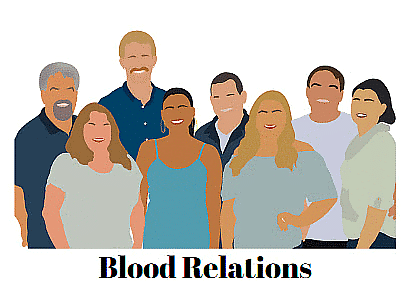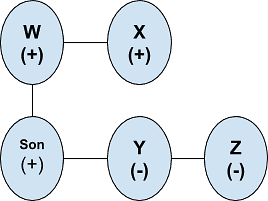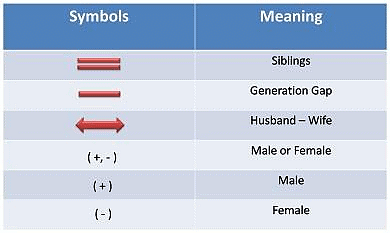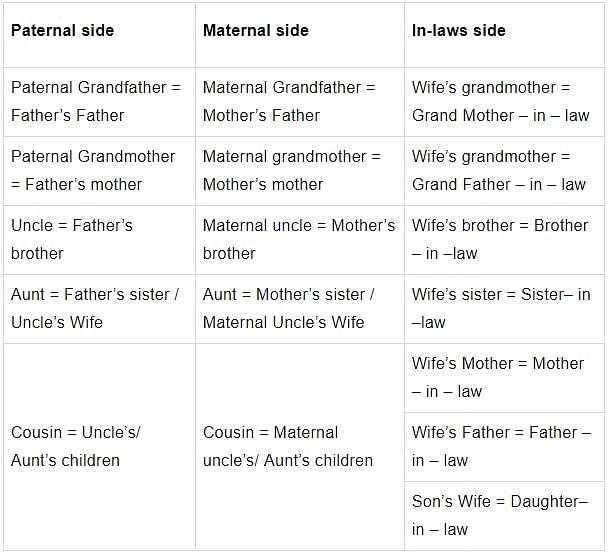Basic Concepts & Types of Questions: Blood Relations | Logical Reasoning (LR) and Data Interpretation (DI) - CAT PDF Download
| Table of contents |

|
| Understanding Blood Relations Questions |

|
| Blood Relations: Type of Questions |

|
| Statement Based Questions |

|
| Puzzle Based Questions |

|
| Symbol Based Questions |

|
| Blood Relations: Tips & Strategies |

|
Blood relation questions in exams are important because they test your thinking skills. You have to figure out how family members are related, solving puzzles and finding patterns. It's like connecting the dots in a family tree. These questions help show if you're good at figuring things out logically. So, in simple words, they check how smart you are in understanding family connections and solving problems in exams.

Blood Relation refers to the connection between two individuals established through their birth rather than through marriage or any other factors. Blood Relation questions entail the analysis of information depicting the familial relationships among its members. In these questions, a series of relationships is presented in informational form, and candidates are required to determine the relationship between two members of the family based on this provided information.
Understanding Blood Relations Questions
- The questions related to blood relations involve working out the familial relationships between people in a family.
- The questions provide some information related to the different family members and the candidates are required to identify the relationship between those particular members.
- The blood relations questions might be of different forms which are explained in detail below.

Prerequisites
To remember easily the relations may be divided into two sides as given below:
Relations of Paternal side
- Father’s father → Grandfather
- Father’s mother → Grandmother
- Father’s brother → Uncle
- Father’s sister → Aunt
- Children of uncle → Cousin
- Wife of uncle → Aunt
- Children of aunt → Cousin
- Husband of aunt → Uncle
Relations of Maternal side
- Mother’s father → Maternal grandfather
- Mother’s mother → Maternal grandmother
- Mother’s brother → Maternal uncle
- Mother’s sister → Aunt
- Children of maternal uncle → Cousin
- Wife of maternal uncle → Maternal aunty
Relations
Blood Relations: Type of Questions
The blood relation questions have several variations to test the understanding and interpretation capabilities of the candidates.
The question types are divided into three categories as:
- Statement-based questions
- Puzzle based questions
- Symbols (or Code) based questions
Whatever the questions are, the candidates are always required to identify the relationship between two particular entities.
The types can further be classified as:
- Single-person blood relation: It involves the relationship between two people only. The questions can be either direct or indirect.
- Mixed blood relation: The relation between several members and the hierarchy is considered. The different variations of questions are explained below along with an example of each.
Statement Based Questions
- In this question type, we have to determine the relationship between two individuals whose relationship is mentioned in a roundabout manner.
- In general, these questions are single-person blood relation types, i.e. involving the relationship between two persons only.
- Look at the problem from one's own perspective meaning that place yourself as the central figure in the relationship question. Then, the solving becomes much easier.
- Example: Pointing to a photograph of a boy Mr.Ram said, “He is the son of the only son of my mother.” How is Mr Ram related to that boy?
Solution:
A. Brother
B. Uncle
C. Cousin
D. Father
Ans: Option D
Solution:
Step 1: There is a photograph and Mr.Ram. The photograph is of a man and hence two squares are represented. But the relationship of Mr.Ram with the person in the photograph is not known yet.
Step 2: The second line says Mr Ram has a mother. Mr Ram is the only son of his mother and Ram has a son and that photograph belongs to Mr Ram’s son. The boy in the photograph is the only son of the son of Ram’s mother i.e., the son of Ram. Hence, Ram is the father of the boy.
The boy in the photograph is the only son of the son of Ram’s mother i.e., the son of Ram. Hence, Ram is the father of the boy.
Solved Examples
Q1: Raja pointed to a lady and said, “She is daughter of the woman who is the mother of the husband of my mother.” Who is the lady, Raja?
(A) Aunt
(B) Grand daughter
(C) Daughter
(D) Sister
Ans: Aunt
Sol: My father is the husband of my mother.
My Father’s mother is my Grandmother.
My Father’s sister is my Grandmother’s daughter.
My father’s sister is my aunt.
Q2: A man pointed to a woman and said, “His mother is your father’s only daughter.” What is the woman’s connection to that person?
(A) Daughter
(B) Sister
(C) Mother
(D) Wife
Ans: Mother
Sol: She is the only daughter of the woman’s father. As a result, the individual is the woman’s son, and the woman is the individual’s mother.
Q3: Anil introduces Rohit as the only son of his father’s wife’s brother. What’s Rohit’s connection to Anil?
(A) Cousin
(B) Son
(C) Uncle
(D) Son-in-law
Ans: Cousin
Sol: My father’s wife is my mother, my mother’s brother is my maternal uncle, and my uncle’s son is my cousin, according to the breakdown of the relationship. As a result, Rohit is Anil’s cousin.
Puzzle Based Questions
- In this type of question, the statements are given in the form of puzzles.
- The relations are mostly of mixed blood relation type and the candidates are required to decode the entire statement and identify the relationship between the given entities.
- Here is an illustration to explain this well.
Example: In a family of W, X, Y and Z, W and X are brothers; while Y and Z are sisters. How are X and Y related if W’s son is Z’s brother?
Solution: From the statement, a simple diagram can be sketched to analyse the relation between Y and Z.
- As the total generations in the question are two, the number of rows in the diagram will also be two.
- The sign (+) implies male, while (-) implies female.
- From the diagram it is clear that Z’s and Y’s father is W. As X is W’s brother, it can be said that X is Y’s uncle.
Solved Examples
Q1 to Q3: Directions to the following questions, Read the given information carefully into answer the questions that follows.
There is a family of six members.
Members are A, B, C, D, E, and F.
A and B are married couple, B being the female member.
B is the daughter-in-law of F.
D is the only son of C.
E is the sister of D.
F's husband is dead.
C is A's brother.
Q1: How is F related to A?
a) Sister
b) Sister-in-law
c) Mother
d) Mother-in-law
Ans: (c)
Sol: F is the mother of A.
Q2: How is E related to C ?
a) Mother
b) Aunt
c) Cousin
d) Daughter
Ans: (d)
Sol: E is C's daughter.
Q3: Who is C to B?
a) Nephew
b) Brother
c) Brother-in-law
d) Son-in-law
Ans: (c)
Sol: C is B's brother-in-law.
Symbol Based Questions
Also known as coded blood relation questions, these involve a set of codes. The candidates are required to decode the sentences (or codes) to identify the relation of the given entities.
Example: Consider the following statements and answer the given question.
- If L * M => L is the husband of M
- L / M => L is the sister of M
- L + M => L is the son of M
How is W and Z related from the following statement: W + X * Y / Z?
Solution: This can be solved by dividing the question and solving from left to right. Now a simple diagram can be made by mentioning the gender and their relations as given below: Thus, it is easily seen that W is the nephew of Z.
Thus, it is easily seen that W is the nephew of Z.
Solved Examples
Read the following informations carefully and answer the questions given below:
'P # Q' means 'P is the father of Q',
'P + Q' means 'P is the mother of Q',
'P - Q' means 'P is the brother of Q',
'P * Q' means 'P is the sister of Q'.
Q1: If A + B # C - D, then A is D's
a) Father
b) Grandmother
c) Sister
d) Grandfather
Ans: (b)
Sol: A + B # C -D means A is the mother of B,
who is the father of C, who is the brother of D,
i.e. , A is the mother D's father.
So, A is D's grandmother.
Q2: Which of the following shows that A is the aunt of E ?
a) A + B - C * D # E
b) A # B * C + D - E
c) A * B # C * D - E
d) A - B + C # D * E
Ans: (c)
Sol: A is the aunt of E means A is the sister of the father of E
i.e. A * B # E. Clearly,
the code in Answer: (c) indicates the same.
Blood Relations: Tips & Strategies
- As the topic is repeated every year in the CAT exam, the candidates are suggested to be thorough with the basics and other related concepts to increase their chances of scoring more in the exam.
- Here some important tips and strategies are given to help the CAT aspirants ace the blood relation question with ease.
1. Be Thorough with the Blood Relation Chart
- It is suggested to get well versed with the blood relation chart to be able to relate and answer the questions easily.
- Here is a chart that details the entire family relation.

2. Be Confident with the Family Tree
- The questions require the candidates to be thorough with the basic relations within a family. In a family tree, the people belonging to the same generation are placed in the same row, while people from different generations are placed in successive rows. The males can be marked as “+” and the females as “-”.
- Drawing a proper family tree for every question is extremely crucial as it will help to identify and analyse the statement easily. The family tree is used above for solving the example questions and it can be seen that the problem becomes much simpler after the tree is drawn accurately.
- However, if the family tree is incorrectly drawn, one might identify a wrong relationship and eventually lose score.
3. Break the Question Statements
- Numerous candidates get confused and fail to analyse the complete question statement at once. This is mainly because the blood relation question statements are sometimes long and confusing.
Example: That girl is Ramu’s sister’s uncle’s wife’s daughter. How is that girl related to Ramu?
Solution: This question seems confusing initially; but, breaking the sentence into parts and then analysing the relation can be extremely easy. Now this sentence can be broken as:
- Ramu’s sister’s uncle = Ramu’s uncle
- Ramu’s uncle’s wife’s son = Ramu’s cousin
- Therefore, that girl is the cousin of Ramu
4. Relate the Problems Personally
- The blood relation concepts can be solved quickly and easily if the questions are related personally.
- So, relate the problems to the self and start analysing the questions strategically.
- Here is an example to understand the importance of relating the problems to self:
Example: That man is Raju’s sister’s mother’s brother. How is that boy related to Raju?
Solution: This question can be either solved with a family tree or by breaking the sentence and relating the relations personally. So, if this question is solved by personal relation, the sentences become easy to analyse.
- Assume that you are Raju himself.
- Now, your sister’s mother = your mother
- Your mother’s brother = your maternal uncle
- Therefore, that man is your (Raju’s) maternal uncle
It should be noted that this approach should only be taken when the question statement is short. For questions with a long sentence, it is suggested to draw the family tree to easily solve the questions.
5. Never Assume Gender
- It is always suggested to avoid assuming the gender of a person based on the given name in the question statement.
- This sometimes leads to losing some crucial marks as the questions are set to test the overall cognitive skills of the candidates.
Example: Tina is the sister of Sukhwinder and Sukhwinder is the brother of Roshan. Then how is Roshan related to Tina?
Solution:- From the above statement, the gender of Roshan is unclear and creates confusion about the same.
- Some might consider the name Roshan as male while others might consider it as female.
- So, coming to a conclusion from the given statement is impossible and that the question requires more information.
|
92 videos|123 docs|94 tests
|
FAQs on Basic Concepts & Types of Questions: Blood Relations - Logical Reasoning (LR) and Data Interpretation (DI) - CAT
| 1. What are the different types of blood relations questions commonly asked in bank exams? |  |
| 2. How can I improve my skills in solving blood relations questions for bank exams? |  |
| 3. What is a statement-based blood relations question? |  |
| 4. Can you explain what a symbol-based blood relations question is? |  |
| 5. What strategies can help in solving blood relations puzzles quickly? |  |
|
92 videos|123 docs|94 tests
|

 The boy in the photograph is the only son of the son of Ram’s mother i.e., the son of Ram. Hence, Ram is the father of the boy.
The boy in the photograph is the only son of the son of Ram’s mother i.e., the son of Ram. Hence, Ram is the father of the boy.


















